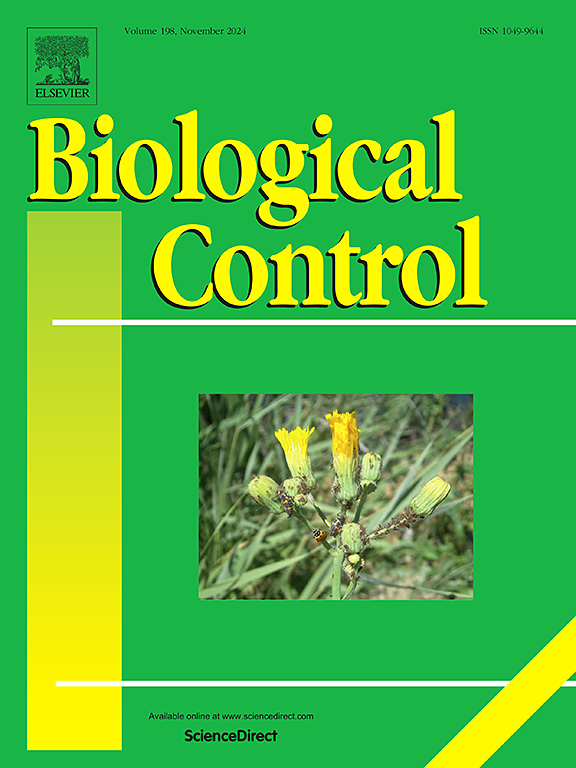Host range, biology, and thermal tolerance of Lygomusotima stria, a potential biological control agent of Old World climbing fern (Lygodium microphyllum) in the USA
IF 3.4
2区 农林科学
Q2 BIOTECHNOLOGY & APPLIED MICROBIOLOGY
引用次数: 0
Abstract
Old World climbing fern, Lygodium microphyllum (Cav.) R. Br., is one of the worst environmental weeds of southern and central Florida. The weed climbs over other plants, forming thick mats that block sunlight to native shrubs and trees. In the introduced range, Old World climbing fern invades much of the southern peninsula of Florida where cost-effective, sustainable control methods are needed. A potential biological control agent, the defoliating moth Lygomusotima stria Solis & Yen, was collected in Thailand and Singapore and examined to determine if it was safe for release. A series of no-choice tests was conducted on neonate and third instars. The results indicated that L. stria could only feed and complete development on three congeners: the target weed; L. microphyllum; another invasive exotic; L. japonicum; and the native L. palmatum. Oviposition tests indicated that adults laid eggs broadly across many taxa but primarily on members of the Lygodium genus. Multigeneration studies indicated that L. stria could sustain a population on L. microphyllum, L. japonicum, and L. palmatum for at least four generations. However, the results of lower lethal temperature studies indicated that the LLT50 for L. stria immatures ranged from −2.8 to 1.6 °C, indicating L. stria will not persist in areas where the more temperate L. palmatum grows. Thus, L. stria has a very narrow host range and we predict it will not pose a threat to L. palmatum as it has a low tolerance for the colder temperatures where this plant grows naturally. The release of L. stria is expected to safely assist in the effort to manage the invasive weed Old World climbing fern.

小叶Lygodium Lygodium microphyllum在美国的潜在生物防治剂Lygomusotima stria的寄主范围、生物学和耐热性
东半球攀缘蕨类,小叶Lygodium microphyllum (Cav.)r . Br。是佛罗里达州南部和中部环境最恶劣的杂草之一。这种杂草爬过其他植物,形成厚厚的草席,阻挡了当地灌木和树木的阳光。在引进范围内,旧大陆攀缘蕨类植物入侵了佛罗里达州南部半岛的大部分地区,在那里需要成本效益高、可持续的控制方法。落叶蛾Lygomusotima stria Solis是一种潜在的生物防治剂。在泰国和新加坡收集,并进行检查,以确定是否可以安全释放。对新生儿和三龄婴儿进行了一系列的无选择测试。结果表明,纹状杆菌仅以3种同系物为食并完成发育:目标杂草;l . microphyllum;另一种外来入侵;l .日本血吸虫;以及本地的棕榈兰。产卵试验表明,成虫在许多分类群中产卵,但主要是在Lygodium属的成员上产卵。多代研究表明,纹状乳杆菌可在小叶乳杆菌、日本乳杆菌和掌状乳杆菌上维持一个种群至少四代。然而,较低致死温度研究结果表明,纹状乳杆菌未成熟的LLT50在−2.8 ~ 1.6°C之间,表明纹状乳杆菌不会在温带棕榈乳杆菌生长的地区持续存在。因此,纹状乳杆菌的寄主范围很窄,我们预测它不会对棕榈乳杆菌构成威胁,因为它对这种植物自然生长的较冷的温度具有较低的耐受性。释放条纹L.有望安全协助管理入侵杂草旧大陆攀缘蕨。
本文章由计算机程序翻译,如有差异,请以英文原文为准。
求助全文
约1分钟内获得全文
求助全文
来源期刊

Biological Control
生物-昆虫学
CiteScore
7.40
自引率
7.10%
发文量
220
审稿时长
63 days
期刊介绍:
Biological control is an environmentally sound and effective means of reducing or mitigating pests and pest effects through the use of natural enemies. The aim of Biological Control is to promote this science and technology through publication of original research articles and reviews of research and theory. The journal devotes a section to reports on biotechnologies dealing with the elucidation and use of genes or gene products for the enhancement of biological control agents.
The journal encompasses biological control of viral, microbial, nematode, insect, mite, weed, and vertebrate pests in agriculture, aquatic, forest, natural resource, stored product, and urban environments. Biological control of arthropod pests of human and domestic animals is also included. Ecological, molecular, and biotechnological approaches to the understanding of biological control are welcome.
 求助内容:
求助内容: 应助结果提醒方式:
应助结果提醒方式:


